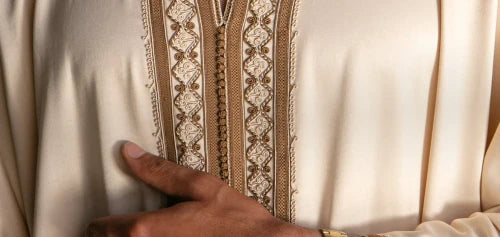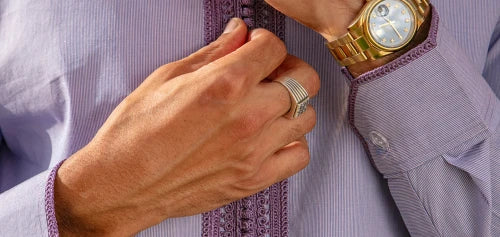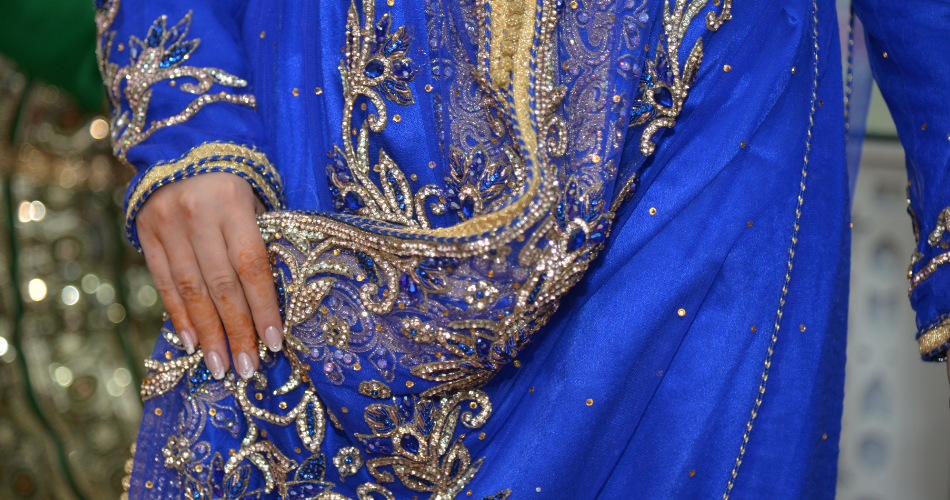When we think of Moroccan fashion, the striking and opulent designs of traditional garments come to mind. Among these, the Takshita stands out as a symbol of grace and tradition, a women's only dress embodying the rich cultural heritage of Morocco. With its intricate details and ceremonial significance, the Takshita is more than just clothing; it's yet another celebration of Moroccan artistry and craftsmanship.
What is a Takshita?
The Takshita (also spelled Taqchita, Tackshita, or Tackchita) is a traditional Moroccan women’s garment that is predominantly worn during special occasions, but most notably at weddings. This elegant outfit is a two-piece ensemble that combines both simplicity and elaborate decoration, reflecting the beauty of Moroccan culture.
The Two Layers of the Takshita
Tahtiya - The Under-Dress
The first layer of the Takshita is known as the tahtiya. It is a dress that serves as the foundation of the outfit. Typically made from fine, understated fabric, the tahtiya is designed to be comfortable and elegant, providing a base upon which the more decorative elements of the Takshita can be showcased. While the fabric used for the tahtiya is of high quality, it is usually less ornate compared to the second layer.
Dfina - The Over-Dress
The second layer, or dfina, is where the true splendor of the Takshita comes to life. This over-dress is often crafted from richly adorned materials, featuring intricate embroidery, beading, or sequins. The dfina is designed to be buttoned up the front using traditional sfifa and akaad closures. These closures are not merely functional; they are integral to the garment’s aesthetic, showcasing traditional Moroccan craftsmanship.

The Artistry of Adornments
One of the most captivating aspects of the Takshita is its embellishments. The dfina is usually richly adorned, with artisans employing a variety of techniques to enhance its visual appeal. Embroidery, often in intricate geometric patterns or floral designs, adds a touch of elegance. Beading and sequins contribute to the garment’s sparkle and shimmer, making it a stunning choice for festive occasions. Some variations also feature luxurious fabrics like velvet or satin, further enhancing the garment's opulence.

The M'damma Belt
To complete the look, many women choose to wear their takshita belted with a m'damma. This belt, which can also be richly adorned, usually matches the dfina and adds a touch of cohesion to the outfit. The m'damma not only serves a decorative purpose but also helps to accentuate the waist, creating a flattering silhouette.

Modern Interpretations and Global Recognition
In recent years, traditional Moroccan clothing, including the Takshita, has gained international recognition. The annual Caftan fashion show, hosted by the Moroccan fashion magazine Femmes du Maroc, showcases modern interpretations of traditional garments such as the takshita, Caftan, and Djellaba. This event highlights how these age-old traditions can be reimagined and celebrated on a global stage.
An interesting tidbit of history involves former U.S. Secretary of State Hilary Clinton, who wore a takshita during a state dinner for the King of Morocco in 1999. Her choice to don this traditional Moroccan garment at such a high-profile event underscores the Takshita’s significance and its role in bridging cultural divides.

Image source: telquel.ma
Fabrics and Prices: The Cost of Elegance
Fabrics Used for Takshitas
The Takshita is celebrated not only for its design but also for the high-quality fabrics used in its creation. The choice of fabric plays a crucial role in defining the garment's overall appearance and feel. Here are some of the most commonly used fabrics:
-
Silk: Silk is a popular choice for the dfina layer due to its luxurious texture and lustrous sheen. It adds an opulent touch to the garment, making it ideal for formal occasions like weddings. Silk fabrics used in takshita often feature intricate embroidery and beading, which complement the fabric's natural shine.
-
Satin: Satin provides a smooth and glossy finish, making it a popular choice for both the tahtiya and dfina layers. Its sleek appearance ensures that the takshita looks polished and refined, with the added benefit of being comfortable to wear.
-
Brocade: Brocade is a fabric known for its elaborate patterns and intricate designs, often woven with metallic threads. It is used for the dfina layer to create a dramatic and eye-catching effect, perfect for festive occasions.
-
Chiffon and Georgette: For a lighter and more airy feel, chiffon and georgette are sometimes used. These fabrics are ideal for more casual or summer events, offering a flowing and delicate appearance.
-
Cotton and Linen: While less common for formal occasions, cotton and linen are sometimes used for the tahtiya layer due to their breathability and comfort. These fabrics are more suited to everyday wear or less formal events.

Takshita Prices
The price of a takshita can vary significantly based on several factors, including the quality of fabrics, the intricacy of the embroidery, and the craftsmanship involved. Here’s a general breakdown of what you can expect:
-
Basic Takshita: For a more straightforward design with minimal embellishments, prices can range from $200 to $500. These takshitas typically use simpler fabrics like cotton or polyester and have less elaborate embroidery.
-
Mid-Range Takshita: Takshitas with moderate embellishments and higher-quality fabrics such as silk or satin generally cost between $500 and $1,200. These garments often feature more detailed embroidery and are suitable for special occasions.
-
High-End Takshita: At the premium end, Takshitas can range from $1,200 to $3,000 or more. These high-end garments are made from luxurious fabrics like velvet or brocade and include intricate beadwork, sequins, and detailed embroidery. Custom designs and designer labels can also drive up the price.
-
Custom and Designer Takshita: For a bespoke Takshita designed by a renowned Moroccan designer, prices can exceed $3,000. These garments are tailored to the wearer’s specifications, featuring unique designs and top-tier craftsmanship.
The Takshita represents a significant investment, reflecting the artistry and tradition embedded in Moroccan fashion. Whether opting for a basic design or a high-end masterpiece, each Takshita is a testament to Morocco’s rich cultural heritage and sartorial excellence.
Embracing the Takshita
The Takshita is more than a garment; it is a piece of Moroccan heritage that reflects the country's history, culture, and artistry. For some people, it's even a collectable item. Its elegant design and rich embellishments make it a cherished choice for special occasions, symbolizing both beauty and tradition. Whether worn at a wedding or showcased in a fashion show, the Takshita continues to captivate and inspire, embodying the timeless elegance of Moroccan fashion.









